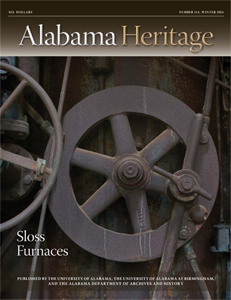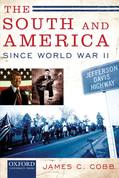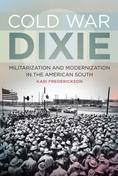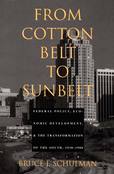|
On the cover: Detail of weathered steam engine components at Sloss Furnaces by Randall Connaughton.
|
FEATURE ABSTRACTS
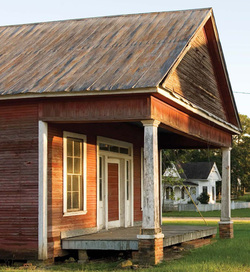 Burnt Corn grew up around a spring on the Old
Burnt Corn grew up around a spring on the Old Federal Road before moving to its current
location a couple of miles up the road. This
building is known simply as the "Red Store."
(Courtesy Robin McDonald)
Nature, Chance, and War: The Birth of Burnt Corn, Alabama
By Jacob F. B. Lowrey III and Carey Cauthen
An advantageous intersection of waterways drew travelers to stop near Burnt Corn, eventually giving rise to a small community that witnessed many significant events in the territory and, eventually, the state. The area hosted a variety of different travelers and visitors, endured the opening episodes of the Creek Wars, and offered the setting for a melodramatic romance—all while remaining an important crossroads.
By Jacob F. B. Lowrey III and Carey Cauthen
An advantageous intersection of waterways drew travelers to stop near Burnt Corn, eventually giving rise to a small community that witnessed many significant events in the territory and, eventually, the state. The area hosted a variety of different travelers and visitors, endured the opening episodes of the Creek Wars, and offered the setting for a melodramatic romance—all while remaining an important crossroads.
Additional Information
For additional reading on Burnt Corn, the authors recommend the following sources:
* The Battle of Burnt Corn Creek found on the Encyclopedia of Alabama's website.
* Riley, Benjamin F. History of Conecuh County, Alabama. Columbus, GA: Thos. Gilbert, Steam Book-Binder, 1881.
* Halbert, H. S. and T. H. Ball. The Creek War of 1813 and 1814. Tuscaloosa: University of Alabama Press, 1995.
* Waselkov, Gregory A. A Conquering Spirit: Fort Mims and the Redstick War of 1813–1814. Tuscaloosa: University of Alabama Press, 2006.
* Collins, Robert P. “‘A Packet from Canada’—Telling Conspiracy Stories on the 1813 Creek Frontier.” In Tohopeka: Rethinking the Creek War and War of 1812. Kathryn Braund. Tuscaloosa: University of Alabama Press, 2012.
About the Author
Jacob F. B. Lowrey III, a native of Burnt Corn, is a CPA in Greenville, South Carolina, the home of his late wife. He recently published “The Story of Captain Sam Dale (Thlucco) and his Double-Barrel Shotgun,” which appeared in Echoes, a monthly magazine of the Escambia County Historical Society, and was republished in the Evergreen Courant, the Monroe Journal, and the Brewton Standard.
Carey Cauthen is a native of Birmingham who worked in Washington, D.C., as an editor before moving back to Alabama. She spent six years at Auburn University as the editor of the Alabama Review and continues to play a role in the Alabama Historical Association. She is now a web designer at the University of Alabama at Birmingham.
Back to Top
For additional reading on Burnt Corn, the authors recommend the following sources:
* The Battle of Burnt Corn Creek found on the Encyclopedia of Alabama's website.
* Riley, Benjamin F. History of Conecuh County, Alabama. Columbus, GA: Thos. Gilbert, Steam Book-Binder, 1881.
* Halbert, H. S. and T. H. Ball. The Creek War of 1813 and 1814. Tuscaloosa: University of Alabama Press, 1995.
* Waselkov, Gregory A. A Conquering Spirit: Fort Mims and the Redstick War of 1813–1814. Tuscaloosa: University of Alabama Press, 2006.
* Collins, Robert P. “‘A Packet from Canada’—Telling Conspiracy Stories on the 1813 Creek Frontier.” In Tohopeka: Rethinking the Creek War and War of 1812. Kathryn Braund. Tuscaloosa: University of Alabama Press, 2012.
About the Author
Jacob F. B. Lowrey III, a native of Burnt Corn, is a CPA in Greenville, South Carolina, the home of his late wife. He recently published “The Story of Captain Sam Dale (Thlucco) and his Double-Barrel Shotgun,” which appeared in Echoes, a monthly magazine of the Escambia County Historical Society, and was republished in the Evergreen Courant, the Monroe Journal, and the Brewton Standard.
Carey Cauthen is a native of Birmingham who worked in Washington, D.C., as an editor before moving back to Alabama. She spent six years at Auburn University as the editor of the Alabama Review and continues to play a role in the Alabama Historical Association. She is now a web designer at the University of Alabama at Birmingham.
Back to Top
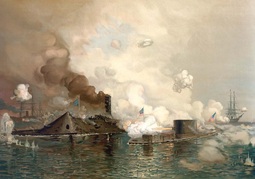 The first-ever battle between ironclad warships
The first-ever battle between ironclad warships pitted the CSS Virginia (left) against the USS
Monitor (right). (Courtesy Library of Congress)
Grey Troops at Blue Mountain
By Greg Starnes
Although it is now a small hamlet, during the Civil War, the Blue Mountain community in Calhoun County played a significant role, serving as a center for troops as well as a munitions depot. The area also sent a number of men to the war, including John Pelham, whose accomplishments earned praise from Robert E. Lee and other commanders. Factors contributing to Blue Mountain’s importance were its role as a railroad hub and the town’s arsenal. Once those fell under attack, Blue Mountain itself fell, marking the end of one of Alabama’s most important Civil War strongholds.
By Greg Starnes
Although it is now a small hamlet, during the Civil War, the Blue Mountain community in Calhoun County played a significant role, serving as a center for troops as well as a munitions depot. The area also sent a number of men to the war, including John Pelham, whose accomplishments earned praise from Robert E. Lee and other commanders. Factors contributing to Blue Mountain’s importance were its role as a railroad hub and the town’s arsenal. Once those fell under attack, Blue Mountain itself fell, marking the end of one of Alabama’s most important Civil War strongholds.
About the Author
Greg Starnes is a freelance writer, professional storyteller, Civil War historian, and award-winning preservationist. A native of Anniston, Alabama, he graduated cum laude from the University of Alabama in 1991 with a BA
in communications. Upon graduation, he started a video production company specializing in sports highlight packages. He has written, or contributed information to, articles published by many Alabama newspapers. Combining
history with haunts, he has written articles for FATE Magazine, as well as two books—a collection of DeKalb County ghost stories, titled Hollers from the Hollows (The Ardent Writer Press), and a southern twist on Charles Dickens’s classic Christmas tale, titled A Secessionist Christmas Carol (Mirror Publishing).
Back to Top
Greg Starnes is a freelance writer, professional storyteller, Civil War historian, and award-winning preservationist. A native of Anniston, Alabama, he graduated cum laude from the University of Alabama in 1991 with a BA
in communications. Upon graduation, he started a video production company specializing in sports highlight packages. He has written, or contributed information to, articles published by many Alabama newspapers. Combining
history with haunts, he has written articles for FATE Magazine, as well as two books—a collection of DeKalb County ghost stories, titled Hollers from the Hollows (The Ardent Writer Press), and a southern twist on Charles Dickens’s classic Christmas tale, titled A Secessionist Christmas Carol (Mirror Publishing).
Back to Top
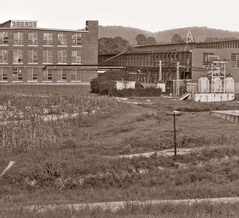 Blue Mountain's mill was purchased by the
Blue Mountain's mill was purchased by the Linen thread Company. (Courtesy
Alabama Dept. of Archives and History)
Mill Village Life at Blue Mountain
By Sarah Cole
After the Civil War, Blue Mountain’s future looked rather bleak. However, with Anniston’s founding during Reconstruction, the entire Calhoun County area experienced a resurgence, mostly driven by iron production. Eventually, Blue Mountain established itself as a textile headquarters, and the town’s mill kept families working for decades. Residents felt they were part of a unique community—one brought together by mechanized production, but unified by the common goal of wholesome family life in a friendly small town. As international business developed, though, the textile economy suffered, and Blue Mountain’s fate grew less secure. Today, the town remains mostly shuttered and forgotten, inhabited by only a few remaining residents who fondly remember the way it once was.
About the Author
Sarah Cole is an award-winning photojournalist for the Alabama Media Group, the Huntsville Times. She holds a degree in English from the University of West Alabama and an MA in journalism from the University of Alabama, where she worked as a graduate teaching assistant as well as a contributing reporter for the Crimson White. She has had works printed in various publications, including the Eagle’s Eye Magazine, Muse Magazine, and the Anniston Star. She is also the recipient of two Alabama APME Newspaper Awards.
Back to Top
By Sarah Cole
After the Civil War, Blue Mountain’s future looked rather bleak. However, with Anniston’s founding during Reconstruction, the entire Calhoun County area experienced a resurgence, mostly driven by iron production. Eventually, Blue Mountain established itself as a textile headquarters, and the town’s mill kept families working for decades. Residents felt they were part of a unique community—one brought together by mechanized production, but unified by the common goal of wholesome family life in a friendly small town. As international business developed, though, the textile economy suffered, and Blue Mountain’s fate grew less secure. Today, the town remains mostly shuttered and forgotten, inhabited by only a few remaining residents who fondly remember the way it once was.
About the Author
Sarah Cole is an award-winning photojournalist for the Alabama Media Group, the Huntsville Times. She holds a degree in English from the University of West Alabama and an MA in journalism from the University of Alabama, where she worked as a graduate teaching assistant as well as a contributing reporter for the Crimson White. She has had works printed in various publications, including the Eagle’s Eye Magazine, Muse Magazine, and the Anniston Star. She is also the recipient of two Alabama APME Newspaper Awards.
Back to Top
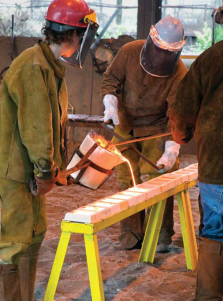 Artists-in-residence pour molten iron into
Artists-in-residence pour molten iron into sand molds carved by an audience of
school children who get to take them home
as souvenirs. (Courtesy Randall
Connaughton)
Sloss Furnaces: The Art of Industry
Text By Bob Wendorf
Photography By Randall Connaughton
Although best known for its functional roles in the economy and history of Birmingham, Sloss Furnaces is also a haunting and beautiful structure. Dating back to the 1880s, the facility remains a focal point of the Birmingham community, educating visitors on the history of pig iron production and offering hands-on activities and tours. And as Randall Connaughton’s photographs demonstrate, it also presents a stunning aesthetic experience, showing how form and function may unite into a thing of beauty.
Text By Bob Wendorf
Photography By Randall Connaughton
Although best known for its functional roles in the economy and history of Birmingham, Sloss Furnaces is also a haunting and beautiful structure. Dating back to the 1880s, the facility remains a focal point of the Birmingham community, educating visitors on the history of pig iron production and offering hands-on activities and tours. And as Randall Connaughton’s photographs demonstrate, it also presents a stunning aesthetic experience, showing how form and function may unite into a thing of beauty.
About the Author
Bob Wendorf is a semi-retired clinical psychologist who teaches part-time at the University of Alabama at Birmingham. He is author of a dozen published articles in family therapy and two popular psychology books, Make Someone Happy (2008) and Tales from the Couch (in progress). He is cofounder and current president of the Japanese Garden Society of Alabama and has lived in Birmingham and Vestavia Hills for more than thirty years.
About the Photographer
Randall Connaughton left architectural practice to complete an MFA in photography from the Savannah College of Art and Design. Born in New York and raised in Hawaii and Miami, Connaughton explores the contrasts of the urban and natural environments, and his approach emphasizes a sensitivity to the nuances of light. His photographs of historic buildings are in the collections of the J.Paul Getty Museum and the Library of Congress. He currently resides in Atlanta. Visit his website.
Back to Top
Bob Wendorf is a semi-retired clinical psychologist who teaches part-time at the University of Alabama at Birmingham. He is author of a dozen published articles in family therapy and two popular psychology books, Make Someone Happy (2008) and Tales from the Couch (in progress). He is cofounder and current president of the Japanese Garden Society of Alabama and has lived in Birmingham and Vestavia Hills for more than thirty years.
About the Photographer
Randall Connaughton left architectural practice to complete an MFA in photography from the Savannah College of Art and Design. Born in New York and raised in Hawaii and Miami, Connaughton explores the contrasts of the urban and natural environments, and his approach emphasizes a sensitivity to the nuances of light. His photographs of historic buildings are in the collections of the J.Paul Getty Museum and the Library of Congress. He currently resides in Atlanta. Visit his website.
Back to Top
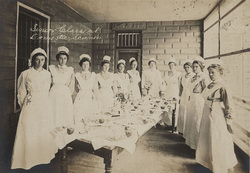 A domestic science class at Bryce Hospital in
A domestic science class at Bryce Hospital in Tuscaloosa, circa 1916. (Alabama Department
of Archives and History)
The Welfare of a Nation: Birmingham’s Young Women and the Emerging Domestic Science Curriculum of the Early Twentieth Century
By Kelsey Scouten Bates
At the turn of the twentieth century, school systems nationwide—including those such as Birmingham’s—started to recognize a new curricular demand: the need to include domestic science courses. Although women were still outside the norm in traditional sciences, domestic science—what would eventually become known colloquially as home economics—legitimized the role of homemakers and recognized the important work women were doing throughout the country. But women didn’t stop there. Domestic science became a platform through which women could affect the health and well-being not only of their families but of their entire communities.
By Kelsey Scouten Bates
At the turn of the twentieth century, school systems nationwide—including those such as Birmingham’s—started to recognize a new curricular demand: the need to include domestic science courses. Although women were still outside the norm in traditional sciences, domestic science—what would eventually become known colloquially as home economics—legitimized the role of homemakers and recognized the important work women were doing throughout the country. But women didn’t stop there. Domestic science became a platform through which women could affect the health and well-being not only of their families but of their entire communities.
About the Author
Kelsey Scouten Bates is the director of development, and was previously assistant archivist, at the Birmingham Public Library. While raising money for the library, she enjoys writing and speaking about the archives collection and history in general. She recently published “Comfort in a Decidedly Uncomfortable Time: Hunger, Collective Memory, and the Meaning of Soul Food in Gee’s Bend, Alabama” in the refereed journal Food and Foodways (January 2013) and is currently working on a memoir about her family’s history and struggle with tuberculosis. Bates is originally from Maryland and has her BA in American history from the University of Maryland, College Park and an MS in writing from Towson University.
Back to Top
Kelsey Scouten Bates is the director of development, and was previously assistant archivist, at the Birmingham Public Library. While raising money for the library, she enjoys writing and speaking about the archives collection and history in general. She recently published “Comfort in a Decidedly Uncomfortable Time: Hunger, Collective Memory, and the Meaning of Soul Food in Gee’s Bend, Alabama” in the refereed journal Food and Foodways (January 2013) and is currently working on a memoir about her family’s history and struggle with tuberculosis. Bates is originally from Maryland and has her BA in American history from the University of Maryland, College Park and an MS in writing from Towson University.
Back to Top
Department ABSTRACTS
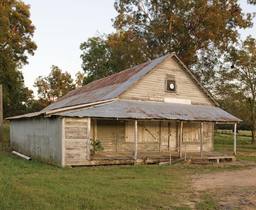 This store in Newbern illustrates the prevailing
This store in Newbern illustrates the prevailing country-store format from colonial times until
after the Civil War. (Courtesy Robin McDonald)
Southern Architecture and Preservation
The Vanishing Country Store
By Robert Gamble
Not so long ago, the American landscape was graced with a number of community focal points—a place where passersby could stop in for a drink or directions, or where locals could congregate on the porch to exchange news or whittle away an afternoon. But as with many elements of earlier times, the country store has faded, too, disappearing in favor of more modernized retail corridors. Robert Gamble, the senior architectural historian for the Alabama Historical Commission, explores the state’s remaining country stores, detailing their architectural and cultural significance.
Additional Information
DO YOU HAVE A FAVORITE COUNTRY STORE? No statewide inventory of landmark country stores exists. If you have a favorite one, please call Lee Anne Wofford at the Alabama Historical Commission at (334) 230-2659, or send an e-mail.
About the Author
Robert Gamble, standing editor of the “Southern Architecture and Preservation” department of Alabama Heritage, is senior architectural historian for the Alabama Historical Commission.
Back to Top
The Vanishing Country Store
By Robert Gamble
Not so long ago, the American landscape was graced with a number of community focal points—a place where passersby could stop in for a drink or directions, or where locals could congregate on the porch to exchange news or whittle away an afternoon. But as with many elements of earlier times, the country store has faded, too, disappearing in favor of more modernized retail corridors. Robert Gamble, the senior architectural historian for the Alabama Historical Commission, explores the state’s remaining country stores, detailing their architectural and cultural significance.
Additional Information
DO YOU HAVE A FAVORITE COUNTRY STORE? No statewide inventory of landmark country stores exists. If you have a favorite one, please call Lee Anne Wofford at the Alabama Historical Commission at (334) 230-2659, or send an e-mail.
About the Author
Robert Gamble, standing editor of the “Southern Architecture and Preservation” department of Alabama Heritage, is senior architectural historian for the Alabama Historical Commission.
Back to Top
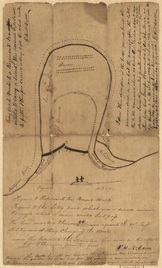 This map of the layout of the
This map of the layout of the Horseshoe Bend battleground
was drawn by R. H. McEwen.
(Courtesy Library of Congress)
Becoming Alabama: Quarter by Quarter
By Joseph W. Pearson, Megan L. Bever, and Matthew L. Downs
Editor’s Note: Alabama Heritage, the Summersell Center for Study of the South, the University of Alabama Department of History, and the Alabama Tourism Department offer this department as a part of the statewide "Becoming Alabama" initiative—a cooperative venture of state organizations to commemorate Alabama’s experiences related to the Creek War, the Civil War, and the civil rights movement. Quarter by quarter we will take you to the corresponding seasons 200, 150, and 50 years ago—sometimes describing pivotal events, sometimes describing daily life, but always illuminating a world in flux. We will wait for the ultimate outcomes as our forebears did—over time. For those joining the story in progress, you can find earlier quarters on our website.
This quarter’s installment of Becoming Alabama takes readers to Andrew Jackson’s skirmishes with Red Stick Creek Indians near the Tallapoosa River, in the days leading up to what would become known as the Battle of Horseshoe Bend. In the Civil War component of this department, we consider the naval exploits of the era, focusing on the Hunley and on Mobile’s Raphael Semmes, who made his name in command of a number of different wartime vessels. And in the civil rights era, we revisit the landmark case New York Times v. Sullivan, in which the U.S. Supreme Court made significant protections of first amendment
rights—and secured the ability of civil rights activists to share their stories from the segregated South.
About the Authors
Joseph W. Pearson is a PhD student in the department of history at the University of Alabama. His research interests include the nineteenth-century South, antebellum politics, and political culture.
Megan L. Bever is currently a doctoral student in the department of history at the University of Alabama. Her research interests include the nineteenth-century South and the Civil War in American culture.
Matthew L. Downs (PhD, Alabama) is an assistant professor of history at the University of Mobile. His dissertation focused on the federal government’s role in the economic development of the Tennessee Valley.
Back to Top
By Joseph W. Pearson, Megan L. Bever, and Matthew L. Downs
Editor’s Note: Alabama Heritage, the Summersell Center for Study of the South, the University of Alabama Department of History, and the Alabama Tourism Department offer this department as a part of the statewide "Becoming Alabama" initiative—a cooperative venture of state organizations to commemorate Alabama’s experiences related to the Creek War, the Civil War, and the civil rights movement. Quarter by quarter we will take you to the corresponding seasons 200, 150, and 50 years ago—sometimes describing pivotal events, sometimes describing daily life, but always illuminating a world in flux. We will wait for the ultimate outcomes as our forebears did—over time. For those joining the story in progress, you can find earlier quarters on our website.
This quarter’s installment of Becoming Alabama takes readers to Andrew Jackson’s skirmishes with Red Stick Creek Indians near the Tallapoosa River, in the days leading up to what would become known as the Battle of Horseshoe Bend. In the Civil War component of this department, we consider the naval exploits of the era, focusing on the Hunley and on Mobile’s Raphael Semmes, who made his name in command of a number of different wartime vessels. And in the civil rights era, we revisit the landmark case New York Times v. Sullivan, in which the U.S. Supreme Court made significant protections of first amendment
rights—and secured the ability of civil rights activists to share their stories from the segregated South.
About the Authors
Joseph W. Pearson is a PhD student in the department of history at the University of Alabama. His research interests include the nineteenth-century South, antebellum politics, and political culture.
Megan L. Bever is currently a doctoral student in the department of history at the University of Alabama. Her research interests include the nineteenth-century South and the Civil War in American culture.
Matthew L. Downs (PhD, Alabama) is an assistant professor of history at the University of Mobile. His dissertation focused on the federal government’s role in the economic development of the Tennessee Valley.
Back to Top
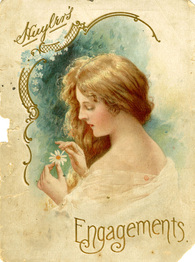 Daphne Cunningham’s diary offers
Daphne Cunningham’s diary offers fascinating insights into her life as
a college student. (Courtesy W. S.
Hoole Special Collections Library)
Alabama Women
Daphne Cunningham’s World: Student Life at Alabama in the 1910s
By Lisa Lindquist Dorr
Among the treasures at the University of Alabama’s W.S. Hoole Special Collections Library is the diary of Daphne Cunningham, a student at the university in the 1910s. As one of the earliest women to enroll at the university, Cunningham occupied a particularly interesting space in the school’s history. Her diary sheds compelling light on everyday life in that era—on campus and beyond, and it details how some attitudes towards dating, dancing, and other relational issues may be different than we might expect a century later.
About the Author
Lisa Lindquist Dorr is associate professor of history and associate dean in the College of Arts and Sciences at the University of Alabama. Joshua D. Rothman, standing editor of the “Alabama Women” department of Alabama Heritage,
is professor of history at the University of Alabama and director of the university’s Frances S. Summersell Center for the Study of the South, which sponsors this department.
Back to Top
Daphne Cunningham’s World: Student Life at Alabama in the 1910s
By Lisa Lindquist Dorr
Among the treasures at the University of Alabama’s W.S. Hoole Special Collections Library is the diary of Daphne Cunningham, a student at the university in the 1910s. As one of the earliest women to enroll at the university, Cunningham occupied a particularly interesting space in the school’s history. Her diary sheds compelling light on everyday life in that era—on campus and beyond, and it details how some attitudes towards dating, dancing, and other relational issues may be different than we might expect a century later.
About the Author
Lisa Lindquist Dorr is associate professor of history and associate dean in the College of Arts and Sciences at the University of Alabama. Joshua D. Rothman, standing editor of the “Alabama Women” department of Alabama Heritage,
is professor of history at the University of Alabama and director of the university’s Frances S. Summersell Center for the Study of the South, which sponsors this department.
Back to Top
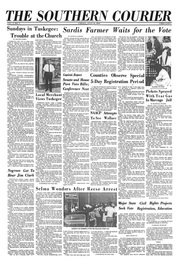 The first issue of the Southern
The first issue of the Southern Courier appeared on July 16,
1965. (Courtesy Tuskegee
University Archives)
Revealing Hidden Collections
Uncovering Tuskegee’s Hidden Legacy: The Southern Courier
By Dana R. Chandler
Tuskegee University bears a long history of engagement with African American and civil rights issues, but one aspect of it that few people know about is its archival collection of the Southern Courier, the Montgomery-based weekly newspaper that educated readers on the civil rights movement from 1965–1968. The Tuskegee collection contains the papers and various materials concerning its founding and publication, offering a rare and valuable window on an institution central to the massive changes sweeping the state and the nation in that era.
About the Author
Dana R. Chandler is the archivist at Tuskegee University. He is a graduate of Auburn University and teaches a variety of history classes. Louis A. Pitschmann, standing editor of the “Revealing Hidden Collections” department of Alabama Heritage, is Dean of the University Libraries at the University of Alabama and director of the Alabama Center for the Book, which cosponsor this department.
Back to Top
Uncovering Tuskegee’s Hidden Legacy: The Southern Courier
By Dana R. Chandler
Tuskegee University bears a long history of engagement with African American and civil rights issues, but one aspect of it that few people know about is its archival collection of the Southern Courier, the Montgomery-based weekly newspaper that educated readers on the civil rights movement from 1965–1968. The Tuskegee collection contains the papers and various materials concerning its founding and publication, offering a rare and valuable window on an institution central to the massive changes sweeping the state and the nation in that era.
About the Author
Dana R. Chandler is the archivist at Tuskegee University. He is a graduate of Auburn University and teaches a variety of history classes. Louis A. Pitschmann, standing editor of the “Revealing Hidden Collections” department of Alabama Heritage, is Dean of the University Libraries at the University of Alabama and director of the Alabama Center for the Book, which cosponsor this department.
Back to Top
 Jonathan Myrick Daniels.
Jonathan Myrick Daniels. (Courtesy Virginia Military
Institute Archives)
Portraits & Landscapes
Remembering Jonathan Myrick Daniels
By Scott A. Merriman
Although not a native of the South, Jonathan Myrick Daniels felt drawn to the area during the civil rights movement, when he took a leave from his seminary studies and traveled to Alabama to volunteer as an activist. Daniels was murdered in the aftermath of a protest, and he later became recognized by the Episcopal Church as a martyr, leading to an annual pilgrimage in which participants retrace his final steps through Hayneville, where a small, somewhat secluded marker memorializes his death.
About the Author
Scott A. Merriman, lecturer of history at Troy University, researches American legal and constitutional history, centering on civil rights and the First Amendment.
Back to Top
Remembering Jonathan Myrick Daniels
By Scott A. Merriman
Although not a native of the South, Jonathan Myrick Daniels felt drawn to the area during the civil rights movement, when he took a leave from his seminary studies and traveled to Alabama to volunteer as an activist. Daniels was murdered in the aftermath of a protest, and he later became recognized by the Episcopal Church as a martyr, leading to an annual pilgrimage in which participants retrace his final steps through Hayneville, where a small, somewhat secluded marker memorializes his death.
About the Author
Scott A. Merriman, lecturer of history at Troy University, researches American legal and constitutional history, centering on civil rights and the First Amendment.
Back to Top
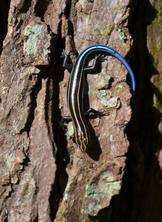 A five-lined skink suns itself.
A five-lined skink suns itself. (Courtesy L. J. Davenport)
Nature Journal
A Vestavia Hills Almanac
By L. J. Davenport
In this quarter’s installment of Nature Journal, our intrepid naturalist takes a closer look at his own yard and one particular pesky plant—a dying silver maple dropping its limbs at inopportune times. Through the course of the year, Davenport considers his nemesis and the history of its species, finally deciding that he just might be able to live with it after all.
About the Author
Larry Davenport is a professor of biology at Samford University, Birmingham.
Back to Top
A Vestavia Hills Almanac
By L. J. Davenport
In this quarter’s installment of Nature Journal, our intrepid naturalist takes a closer look at his own yard and one particular pesky plant—a dying silver maple dropping its limbs at inopportune times. Through the course of the year, Davenport considers his nemesis and the history of its species, finally deciding that he just might be able to live with it after all.
About the Author
Larry Davenport is a professor of biology at Samford University, Birmingham.
Back to Top
Reading the Southern Past
The End of the Old South
By Stephen Goldfarb
This quarter, Stephen Goldfarb explores the post–World War II South, looking at its history and the rampant changes occurring as veterans returned home from war. Among the books under review are James C. Cobb’s The South and America since World War II (Oxford University Press, 2012), Bruce J. Schulman’s From Cotton Belt to Sunbelt: Federal Policy, Economic Development, and the Transformation of the South, 1938–1980 (Duke University Press, 1994), and Kari Frederickson’s book Cold War Dixie: Militarization and Modernization in the American South (University of Georgia Press, 2013).
About the Author
Stephen Goldfarb holds a PhD in the history of science and technology. He retired from a public library in 2003.
Back to Top
The End of the Old South
By Stephen Goldfarb
This quarter, Stephen Goldfarb explores the post–World War II South, looking at its history and the rampant changes occurring as veterans returned home from war. Among the books under review are James C. Cobb’s The South and America since World War II (Oxford University Press, 2012), Bruce J. Schulman’s From Cotton Belt to Sunbelt: Federal Policy, Economic Development, and the Transformation of the South, 1938–1980 (Duke University Press, 1994), and Kari Frederickson’s book Cold War Dixie: Militarization and Modernization in the American South (University of Georgia Press, 2013).
About the Author
Stephen Goldfarb holds a PhD in the history of science and technology. He retired from a public library in 2003.
Back to Top
